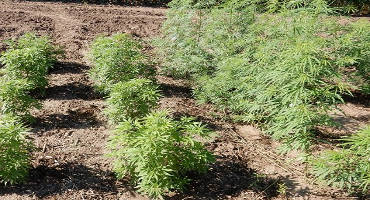Hemp (Cannabis sativa) has been a major crop globally for centuries, used for the production of fiber, medicine, and other products. Its production has been regulated since 1937, along with bans on psychoactive substances such as marijuana, cocaine, and opiates. Production of hemp, including industrial hemp, peaked in 1943 but was fully banned in the 1970s. (Hemp is differentiated from marijuana by its lower levels of THC (tetrahydrocannabinol), the psychoactive chemical in the plant. The dry weight of the hemp flower – or any other plant part – must be less than 0.3% Delta-9 THC.)
The US domestic markets for industrial hemp products have been supplied primarily by China and Canada. France is the global leader in industrial hemp production.
In the 2018 farm bill, industrial hemp was removed from the controlled substance list and hemp farmers were made eligible for federal crop insurance and researchers were enabled to apply for federal grants. In that year US hemp production increased to 78,176 acres, an increase of more than 200% from 2017 (Table 1), when hemp was grown for research.
| State | 2017 | 2018 |
|---|
| Colorado | 9,700 | 21,578 |
| Kentucky | 3,271 | 6,700 |
| Minnesota | 1,205 | 710 |
| Montana | 542 | 22,000 |
| Nevada | 417 | 1,881 |
| New York | 2,000 | 2,240 |
| North Carolina | 965 | 3,184 |
| North Dakota | 3,020 | 2,778 |
| Oregon | 3,469 | 7,808 |
| Tennessee | 200 | 3,338 |
| Vermont | 575 | 1,820 |
| Wisconsin | NA | 1,850 |
| Other states | 349 | 2,289 |
| Total | 25,713 | 78,176 |
Nebraska leglized hemp production for fiber, grain, or cannabidiol (CBD) in 2019, with the condition that plant parts of industrial hemp have a THC concentration of less than 0.3%. Production and use of marijuana and THC for medical and recreational purposes remain illegal in Nebraska.
University of Nebraska-Lincoln Extension agricultural publications generally are based on the interpretation of research information from Nebraska or elsewhere in the Midwest. However, such information is not available relative to hemp production due to previous restrictions on research in the U.S. This publication relies heavily on research findings from Europe and Canada (Struik et al., 2000). Since the production of hemp is beginning anew in Nebraska, we considered it important to offer information and guidelines now with the expectation of substantial changes with increased research findings and farmer experiences. Therefore, feedback and information to the authors to improve the information provided in these three stories is requested.
On a Hemp Program website, the Nebraska Department of Agriculture has posted information on the pilot program and application process, frequently asked questions, and a list of pesticides available for hemp production.
"We [NDA] look forward to USDA providing federal guidelines to help ensure the success of a full program for 2020 and beyond," the site notes.
Rapid increases in hemp production are projected due to demand for CBD and other hemp products. The president of the U.S. Hemp Authority, an industry group, wrote in 2018 “the hemp oilseed, fiber, and extract industries are at the threshold of an economic revolution.”
Many questions remain. Will the health benefits of CBD be confirmed? How will farmers keep plants from exceeding the legal limit of 0.3% THC, the psychoactive component of marijuana? Which hemp varieties perform best in which environments? What are good agronomic practices for hemp production?
Good Agronomic Practices for Hemp

Figure 2. University of Nebraska-Lincoln research trials comparing production of two varieties of hemp. On the left is a CBD variety and on the right is one grown for fiber and grain.